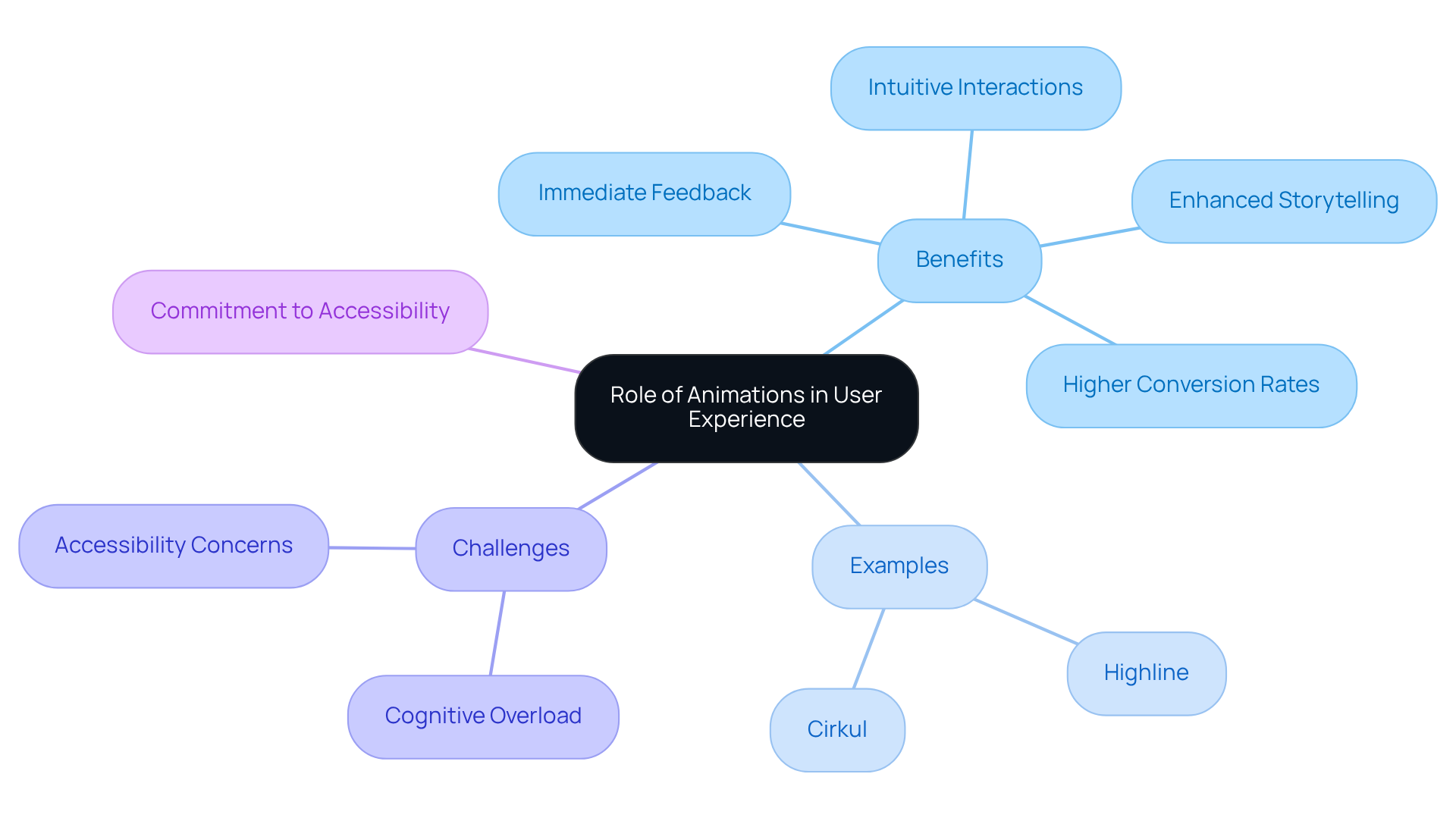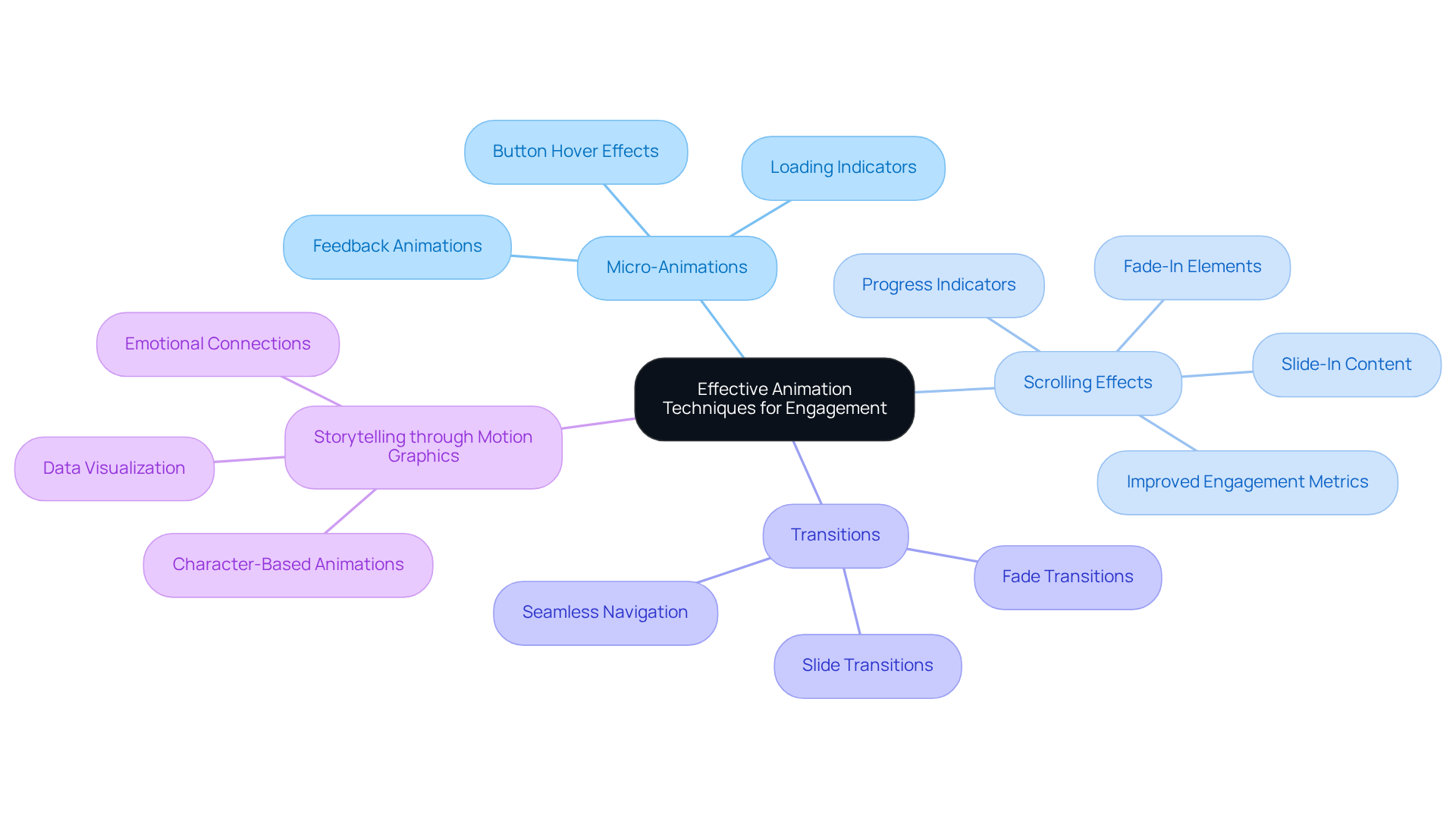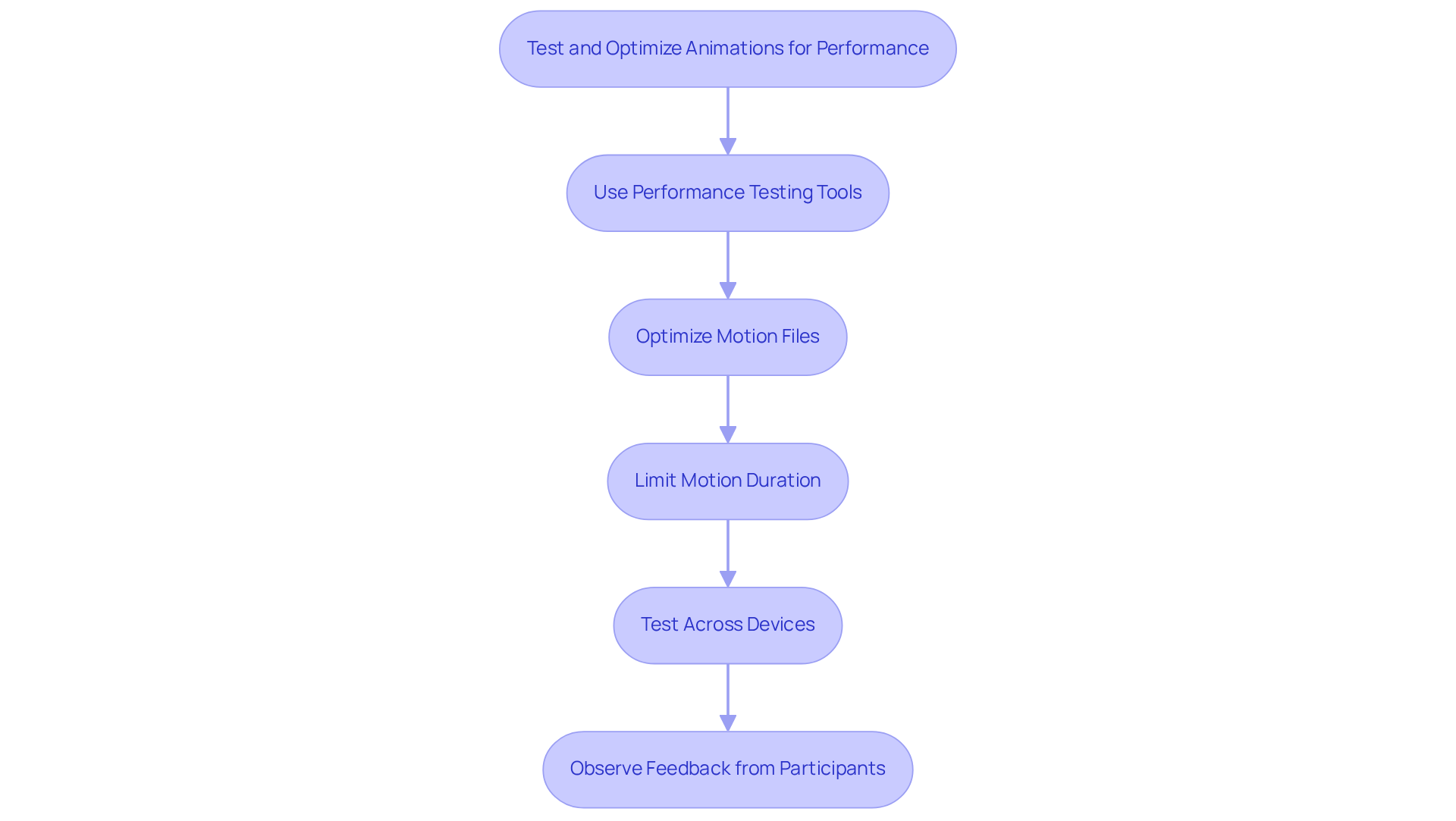Overview
The article addresses a common challenge faced by many tech startup founders: low user engagement on their websites. This issue can lead to frustration, as it not only affects user satisfaction but also impacts conversion rates. Imagine pouring your heart into your product, only to see users disengage. It’s disheartening, isn’t it?
However, there is hope. Mastering animations on your website can significantly enhance user engagement and performance. Effective animations offer immediate feedback, enriching the storytelling experience and weaving a cohesive user journey. When users feel connected and understood, their satisfaction grows, leading to higher conversion rates.
Yet, it’s crucial to remember that not all animations are created equal. Testing and optimizing these animations is essential to ensure they enhance rather than hinder site performance. By focusing on this aspect, you can create a nurturing environment for your users, making them feel valued and appreciated.
In conclusion, by embracing the power of animations, you can transform the user experience on your website. Let’s work together to ensure that your site not only attracts users but also keeps them engaged and satisfied. Your journey towards mastering animations can lead to a thriving community around your startup, filled with users who truly appreciate what you have to offer.
Introduction
Animations have become an essential part of modern web design, transforming static interactions into dynamic experiences that truly engage users. For many designers, the challenge lies in how to leverage these animations effectively. While they can enhance user engagement and make complex information more digestible, there’s a fine line between captivating users and overwhelming them.
We understand this struggle, and it’s important to address it thoughtfully. How can brands implement animations without sacrificing performance or user comfort? This article explores the vital role of animations in user experience, sharing best practices and innovative techniques that elevate website interactions while being mindful of potential pitfalls.
Together, we can navigate this journey towards creating a more engaging web experience.
Understand the Role of Animations in User Experience
Animations on websites play a crucial role in enhancing the user experience, addressing a common challenge many face: how to make interactions feel more intuitive and engaging. Without , users may feel uncertain about whether their actions, like button presses or form submissions, are being recognized. This uncertainty can lead to frustration and disengagement. Imagine a user hesitating, unsure if their submission went through—this is a pain point we can alleviate.
By incorporating subtle animations on websites, we can provide immediate feedback, reassuring users that their actions are being processed. Furthermore, visuals can enrich storytelling, guiding users through content in a way that creates a cohesive narrative flow, making complex information easier to digest. Research indicates that well-executed visual effects can significantly enhance retention and satisfaction; indeed, it has been shown that thoughtfully designed microeffects can boost satisfaction by as much as 20%.
Prominent brands like Highline and Cirkul have successfully harnessed visual effects to elevate their online interactions. They utilize captivating transitions and visual signals that not only engage users but also create a more enjoyable experience. UX designers emphasize that intentional animations on websites do more than just grab attention; they can lead to higher conversion rates, highlighting the importance of deliberate design in our digital landscape.
However, it’s vital to remain mindful of potential challenges, such as cognitive overload or accessibility concerns for individuals with disabilities. We must ensure that animations fulfill their intended purpose without detracting from the overall experience. By addressing these challenges thoughtfully, we can create a nurturing environment where every user feels valued and understood. At RNO1, we are committed to helping tech startup founders navigate these complexities, ensuring that every interaction is both engaging and accessible.

Implement Effective Animation Techniques for Engagement
Engaging users through animations can often feel overwhelming for designers, as they strive to create experiences that resonate. One common challenge is ensuring that interactions feel responsive and intuitive. Micro-animations can be a gentle solution to this problem. These subtle animations, such as button hovers or loading indicators, provide instant feedback, enhancing the interaction. For instance, when a button slightly grows upon being hovered over, it signals its clickability, gently guiding users toward action. This approach not only fosters engagement but can also lead to significant outcomes; research shows that micro-animations can contribute to a 40% increase in revenues for brands that prioritize personalized experiences.
As users scroll down a page, they often crave a sense of progression. Scrolling effects can nurture this desire, activating as individuals navigate through content. Elements that fade in or slide into view draw attention to important information, encouraging users to explore further. It's heartening to note that websites utilizing these effects often see considerable improvements in engagement metrics, including longer session lengths and higher interaction rates. A case study on 'Enhancing Website Usability and Navigation' highlights how thoughtful animation can reduce friction and improve user experience.
Transitions also play a crucial role in creating a seamless navigation experience. Smooth transitions between different states or pages can enhance the flow, making the journey through content feel cohesive. For example, using fade or slide transitions when moving from one section to another creates a refined experience. However, it's important to approach this with care; overusing transitions can lead to distraction and frustration, which no designer wants for their users.
Storytelling through motion graphics is another powerful technique, especially on landing pages where capturing attention is vital. Visuals that tell a story can , making it engaging and digestible. Michelle Connolly, founder of Educational Voice, wisely notes that "motion graphics should prioritize the individual first and the brand second," a reminder of the importance of user-focused design in our efforts.
By thoughtfully applying these methods and being mindful of common pitfalls—like overloading pages with visuals or neglecting the audience's needs—brands can cultivate a captivating and interactive environment. This not only encourages exploration and engagement but ultimately enhances performance and satisfaction. Remember, each step taken in design is a step toward fostering a more connected and supportive user experience.

Test and Optimize Animations for Performance
To ensure that visual effects enhance user experience without compromising performance, effective testing and optimization are essential. Many founders face the challenge of balancing stunning visuals with swift performance, which can be a source of frustration. The good news is that there are best practices that can help navigate this journey:
- Use Performance Testing Tools: Leverage tools like Google PageSpeed Insights and GTmetrix to analyze how transitions impact load times and overall site performance. These tools offer valuable insights into which visuals may be hindering site speed, allowing for targeted enhancements. For instance, a performance audit revealed that reducing DOM elements from over 2,000 to approximately 1,400 improved the Google Lighthouse performance score from 79 to 99. This kind of improvement can make a significant difference in user satisfaction.
- Optimize Motion Files: Ensure motion files are web-optimized. Utilizing formats like can greatly decrease file sizes while preserving visual quality. This results in quicker load times and a smoother experience for users. As Jared Stanley noted, "Using these tactics, we went from +2,000 DOM elements down to ~1,400 and improved our Google Lighthouse performance score." Such strategies can truly transform how users interact with your site.
- Limit Motion Duration: Keep movements concise and purposeful. Studies show that visuals lasting more than 300 milliseconds can irritate individuals, so strive for fast, brisk visuals that enhance the experience without leading to distraction. This approach supports participant engagement without overwhelming them, creating a more pleasant interaction.
- Test Across Devices: Confirm that visual effects operate consistently across different devices and screen sizes. What functions smoothly on a desktop might not adapt well to mobile, making thorough testing essential for a consistent interaction. This is especially crucial since various devices might process visuals in distinct ways, affecting audience satisfaction. By ensuring compatibility, you foster a more inclusive experience for all users.
- Observe Feedback from Participants: After introducing visual elements, actively collect responses to assess their influence on the overall interaction. This feedback can help identify issues and highlight areas for further enhancement. Additionally, be mindful of common pitfalls, such as utilizing properties that activate layout or paint, which can impede fluidity in motion. Listening to your users is a vital part of the improvement process.
By adhering to these practices, you can create animations that are not only engaging but also optimized for performance. This nurturing approach ultimately leads to an improved user experience, fostering a deeper connection with your audience.

Conclusion
Animations play a vital role in web design, offering a unique opportunity to enhance user engagement and overall experience. Many designers face the challenge of creating interactions that not only capture attention but also reassure users as they navigate through content. By thoughtfully integrating animations, you can foster intuitive interactions that guide users seamlessly, alleviating the anxiety that often accompanies digital experiences. This strategic use of visual effects not only captivates attention but also nurtures a sense of connection, ultimately leading to higher conversion rates and increased user satisfaction.
Reflecting on this, it’s clear that implementing effective animation techniques, such as micro-animations and smooth transitions, is crucial for creating a responsive and engaging environment. Brands like Highline and Cirkul exemplify how thoughtful animations can truly elevate online interactions. However, it’s essential to remain mindful of potential challenges—like cognitive overload and accessibility—to ensure that animations serve their intended purpose without detracting from the user experience.
In our rapidly evolving digital landscape, we must recognize the immense value that animations bring to web design. As trends shift and user expectations grow, embracing innovative animation techniques becomes crucial for brands striving to enhance user engagement. By testing and optimizing these elements, you can craft captivating experiences that resonate deeply with users, fostering lasting connections. The call to action is clear: prioritize thoughtful animation in your web design efforts to unlock the full potential of user interactions and drive performance in 2025 and beyond. Together, let’s create experiences that not only engage but also nurture the relationships we build with our users.
Frequently Asked Questions
What is the role of animations in user experience on websites?
Animations enhance user experience by making interactions feel more intuitive and engaging. They provide immediate feedback to users, reassuring them that their actions, such as button presses or form submissions, are being recognized.
How do animations help alleviate user uncertainty?
Without effective animations, users may feel uncertain about whether their actions have been acknowledged, leading to frustration. Subtle animations can help reduce this uncertainty by confirming that actions are being processed.
What benefits do animations provide in storytelling on websites?
Animations enrich storytelling by guiding users through content and creating a cohesive narrative flow. This makes complex information easier to digest and enhances overall user engagement.
How do well-executed visual effects impact user satisfaction?
Research indicates that well-executed visual effects can significantly enhance user retention and satisfaction, with thoughtfully designed microeffects potentially boosting satisfaction by as much as 20%.
Can you provide examples of brands that effectively use animations?
Prominent brands like Highline and Cirkul successfully utilize captivating transitions and visual signals to engage users and create a more enjoyable online experience.
What are some potential challenges associated with using animations?
Potential challenges include cognitive overload and accessibility concerns for individuals with disabilities. It is important to ensure that animations enhance rather than detract from the overall user experience.
How can designers create an engaging and accessible environment with animations?
Designers should thoughtfully address challenges related to animations, ensuring they fulfill their intended purpose while making every user feel valued and understood. This includes considering accessibility and avoiding overwhelming users with excessive animations.




